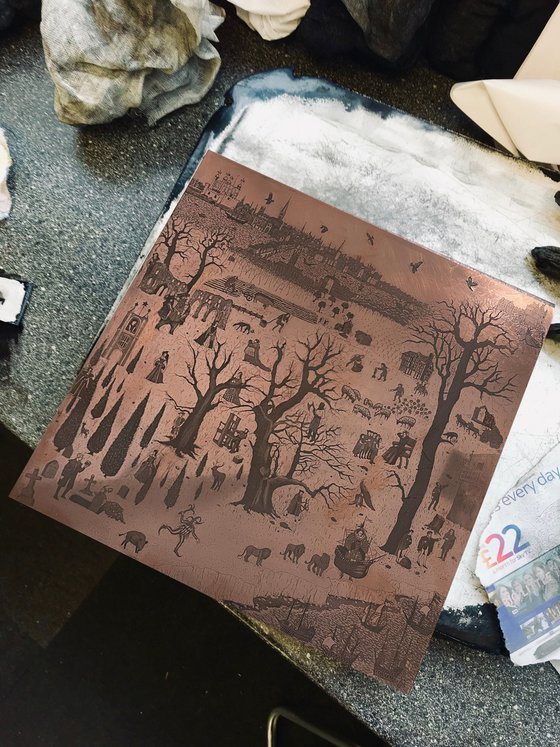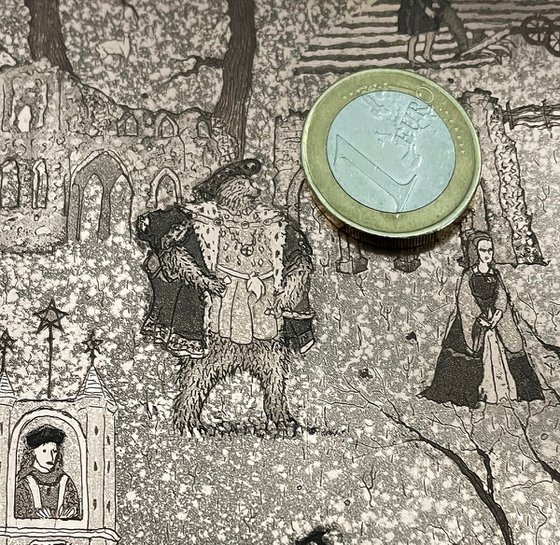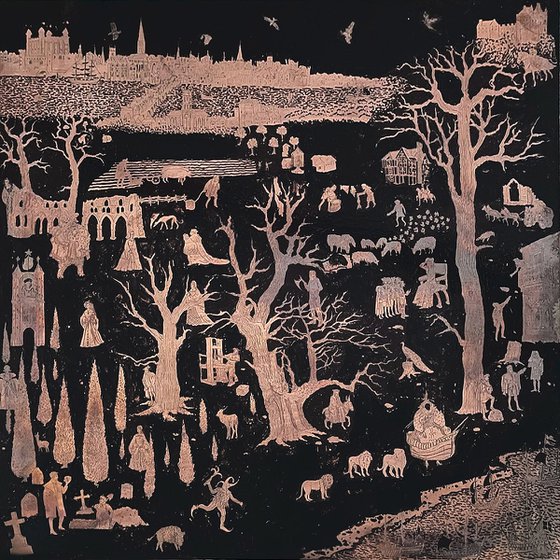Main Navigation
Artwork description:
The 'Golden Age' is a narrative etching which depicts some of the key events and figures of the English renaissance period. Through a series of vignettes a number stories interlace to create an exciting visual feast. This is the second print in a series of ‘Histories’. This print was exhibited at the Royal Academy Summer Exhibition.
Synopsis:
In the top left of the image Mary Queen of Scots flees Scotland on horseback following her downfall in 1567.
Extending from the top right of the image is London, now a prosperous city, still dominated by The Tower.
The mid-distance is a pastoral scene of everyday life.
To the left is the balcony scene from Romeo & Juliet, watched ominously by a large crow.
Central left of the image, a childless Queen Mary Tudor sits on a throne and screams in torment at a group of madrigal singing children.
Central to the image is the axe-wielding executioner, an ever-present threat of the times. Below him William Caxton is busy on his printing press, and thereby introducing the printed word into English culture.
The central-right section of the image is dominated by Henry VIII, here depicted as a great bear. To his right is his father, Henry VII, an often neglected monarch sitting in his Star Chamber. Accompanying Henry VIII are his 6 wives.
Catherine of Aragon is seen behind the king, to the right, peeping from behind the ruins of a monastery.
Anne Boleyn stands to the left of the king, caught in a pincer movement between the monarch and Cardinal Wolseley
Jane Seymour stands below the king, her son, the boy King Edward VI coyly peeps out from behind a tree looking at Catherine Parr.
Anne of Cleves stands firmly in the conifers.
Poor Catherine Howard is lost in the woods, below Cardinal Wolesley and within sight of the axe welding executioner.
Catherine Parr is furthest from the king, watching Hamlet.
Hamlet gives his Alas poor Yorick speech watched on by a grave digger and Queen Catherine Parr.
Dominating the lower left of the image and facing the threat of the Spanish Armada, is good Queen Bess fully attired in battle dress. Accompanying the Queen are the three lions of England. En route to support the monarch is Lord Chancellor Burghley on his mule.
On the far left, a troop of wandering minstrels bring music, song and levity to the proceedings.
In the foreground a jester kicks up his heels and a bemused boar stares out at the viewer.
Materials used:
etching on copper printed on a heavyweight paper
Tags:
#london #beard #history #renaissance #england #shakespeare #romeo and #stories #jester #henry viii #hamlet #lions mane #mary queen #elizabeth iFeatured by our Editors:
Golden Age (2023) Etchings & engravings
by Tim Southall
19 Artist Reviews
£275
- Etchings & engravings on Paper
- From a limited edition of 75
- Size: 38 x 38 x 0.1cm (unframed) / 30 x 30cm (actual image size)
- Signed and numbered on the front
- Style: Illustrative
- Subject: People and portraits
Loading
Artwork description
The 'Golden Age' is a narrative etching which depicts some of the key events and figures of the English renaissance period. Through a series of vignettes a number stories interlace to create an exciting visual feast. This is the second print in a series of ‘Histories’. This print was exhibited at the Royal Academy Summer Exhibition.
Synopsis:
In the top left of the image Mary Queen of Scots flees Scotland on horseback following her downfall in 1567.
Extending from the top right of the image is London, now a prosperous city, still dominated by The Tower.
The mid-distance is a pastoral scene of everyday life.
To the left is the balcony scene from Romeo & Juliet, watched ominously by a large crow.
Central left of the image, a childless Queen Mary Tudor sits on a throne and screams in torment at a group of madrigal singing children.
Central to the image is the axe-wielding executioner, an ever-present threat of the times. Below him William Caxton is busy on his printing press, and thereby introducing the printed word into English culture.
The central-right section of the image is dominated by Henry VIII, here depicted as a great bear. To his right is his father, Henry VII, an often neglected monarch sitting in his Star Chamber. Accompanying Henry VIII are his 6 wives.
Catherine of Aragon is seen behind the king, to the right, peeping from behind the ruins of a monastery.
Anne Boleyn stands to the left of the king, caught in a pincer movement between the monarch and Cardinal Wolseley
Jane Seymour stands below the king, her son, the boy King Edward VI coyly peeps out from behind a tree looking at Catherine Parr.
Anne of Cleves stands firmly in the conifers.
Poor Catherine Howard is lost in the woods, below Cardinal Wolesley and within sight of the axe welding executioner.
Catherine Parr is furthest from the king, watching Hamlet.
Hamlet gives his Alas poor Yorick speech watched on by a grave digger and Queen Catherine Parr.
Dominating the lower left of the image and facing the threat of the Spanish Armada, is good Queen Bess fully attired in battle dress. Accompanying the Queen are the three lions of England. En route to support the monarch is Lord Chancellor Burghley on his mule.
On the far left, a troop of wandering minstrels bring music, song and levity to the proceedings.
In the foreground a jester kicks up his heels and a bemused boar stares out at the viewer.
Materials used:
etching on copper printed on a heavyweight paper
Tags:
#london #beard #history #renaissance #england #shakespeare #romeo and #stories #jester #henry viii #hamlet #lions mane #mary queen #elizabeth iFeatured by our Editors:
14 day money back guaranteeLearn more






